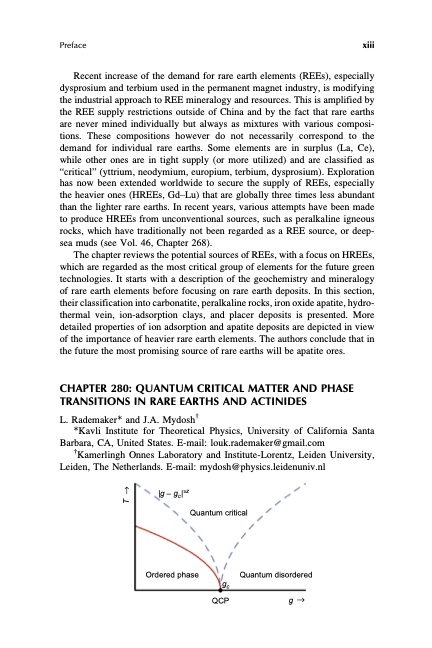
PDF Publication Title:
Text from PDF Page: 008
Preface xiii Recent increase of the demand for rare earth elements (REEs), especially dysprosium and terbium used in the permanent magnet industry, is modifying the industrial approach to REE mineralogy and resources. This is amplified by the REE supply restrictions outside of China and by the fact that rare earths are never mined individually but always as mixtures with various composi- tions. These compositions however do not necessarily correspond to the demand for individual rare earths. Some elements are in surplus (La, Ce), while other ones are in tight supply (or more utilized) and are classified as “critical” (yttrium, neodymium, europium, terbium, dysprosium). Exploration has now been extended worldwide to secure the supply of REEs, especially the heavier ones (HREEs, Gd–Lu) that are globally three times less abundant than the lighter rare earths. In recent years, various attempts have been made to produce HREEs from unconventional sources, such as peralkaline igneous rocks, which have traditionally not been regarded as a REE source, or deep- sea muds (see Vol. 46, Chapter 268). The chapter reviews the potential sources of REEs, with a focus on HREEs, which are regarded as the most critical group of elements for the future green technologies. It starts with a description of the geochemistry and mineralogy of rare earth elements before focusing on rare earth deposits. In this section, their classification into carbonatite, peralkaline rocks, iron oxide apatite, hydro- thermal vein, ion-adsorption clays, and placer deposits is presented. More detailed properties of ion adsorption and apatite deposits are depicted in view of the importance of heavier rare earth elements. The authors conclude that in the future the most promising source of rare earths will be apatite ores. CHAPTER 280: QUANTUM CRITICAL MATTER AND PHASE TRANSITIONS IN RARE EARTHS AND ACTINIDES L. Rademaker* and J.A. Mydosh† *Kavli Institute for Theoretical Physics, University of California Santa Barbara, CA, United States. E-mail: louk.rademaker@gmail.com †Kamerlingh Onnes Laboratory and Institute-Lorentz, Leiden University, Leiden, The Netherlands. E-mail: mydosh@physics.leidenuniv.nl |g – gc|uz Quantum critical Ordered phase Quantum disordered QCP g→ gc T→PDF Image | HANDBOOK ON THE PHYSICS AND CHEMISTRY OF RARE EARTHS

PDF Search Title:
HANDBOOK ON THE PHYSICS AND CHEMISTRY OF RARE EARTHSOriginal File Name Searched:
Chemistry-Rare-Earths-49.pdfDIY PDF Search: Google It | Yahoo | Bing
Sulfur Deposition on Carbon Nanofibers using Supercritical CO2 Sulfur Deposition on Carbon Nanofibers using Supercritical CO2. Gamma sulfur also known as mother of pearl sulfur and nacreous sulfur... More Info
CO2 Organic Rankine Cycle Experimenter Platform The supercritical CO2 phase change system is both a heat pump and organic rankine cycle which can be used for those purposes and as a supercritical extractor for advanced subcritical and supercritical extraction technology. Uses include producing nanoparticles, precious metal CO2 extraction, lithium battery recycling, and other applications... More Info
| CONTACT TEL: 608-238-6001 Email: greg@infinityturbine.com | RSS | AMP |